Esta entrada fue actualizada el 18 de marzo del 2016.
(This post was updated March 18th, 2016.)
The Mangrove of Puntarenas
Pitahaya of Puntarenas, Puntarenas
La gran belleza de la espátula rosada
(The great beauty of the Roseate Spoonbill)
The mangrove of Puntarenas is a place rarely visited, because most people simply visit the Port of Puntarenas.
The place is simply spectacular, with calm waters and the green of the mangroves as well as the large presence of birds. It is extremely interesting to get to the pier used by people for many years when they came from Monteverde, Aranjuez, Miramar and other places, to travel by boat to the Port of Puntarenas.
However, not everything is good and the Puntarenas mangrove has been threatened for some time, but to date, the measures have failed to halt the deterioration. In the seventies, Puntarenas mangroves had a stretch of four kilometres inland and at present the bands are of 200 to 500 meters.
The increase of population in areas surrounding mangroves also causes pollution of the water with chemicals, fecal material and sedimentation.
Furthermore, the exploitation of material from the Aranjuez, Ciruelas, Guacimal, Naranjo, Lagarto and Seco Rivers, where vegetation is losing its banks, increases the problem.
To this, we must add the damage caused by certain crops such as sugar cane that every year eliminates a large number of hectares of mangrove. Other activities such as shrimp farming and salt production aggravates the situation.
Also, there has been the invasion of squatters and settlers within the estuary at the mouth of the Naranjo River. There are towns within the estuary with electrification, roads and aqueducts. There are also docks and channels that were built from the estuary to Punta Morales without the consent of the Ministry of Environment, Energy and Telecommunications.
The problem is complex and the solution too. However, it should be aware that it is our duty to conserve and preserve the most important resource we have: our nature. Without it we are nothing.
-----------------------------------
We highly recommend the tour with Mr. Ronald Montero-Rodríguez, an experience guide who is resident of Puntarenas Port. His knowledge and goods manners are excelent, making the tour worthwile. Mr. Montero-Rodríguez can be located at the following telephone number: (506)-8939-0101 or in Facebook: Ronald Montero-Rodríguez.
-----------------------------------
Special gratitude to Mr. Oscar Ramírez Alán of the Ornithological Association of Costa Rica and Mr. Álvaro Herrera Villalobos of the INBIO for helping to identify some of the birds.
-----------------------------------
Numbers in parenthesis refer to page number of the book “The Birds of Costa Rica”, by Richard Garrigues and Robert Dean (2007), where you can find a description of the bird.
-----------------------------------
Click on the images to enlarge.
-----------------------------------
El estero de Puntarenas es un sitio poco visitado, ya que la mayoría de las personas se limitan a visitar el Puerto de Puntarenas.
El lugar es sencillamente espectacular, con aguas tranquilas y el verdor de los manglares, así como la gran presencia de aves. Es sumamente interesante llegar al atracadero que utilizaban las personas hace muchos años cuando venían de Monteverde, Aranjuez, Miramar y otros pueblos para llegar en bote al Puerto de Puntarenas.
Sin embargo, no todo es bueno y el manglar de Puntarenas está siendo amenazado desde hace tiempo, sin que a la fecha se haya logrado detener el deterioro. En los años setenta, el manglar de Puntarenas contaba con una franja de cuatro kilómetros tierra adentro y en la actualidad son franjas de 200 a 500 metros.
El aumento de población en las zonas aledañas a los humedales, también provoca la contaminación de sus aguas con compuestos químicos, materia fecal y sedimentación.
Asimismo, la explotación de material de los ríos Aranjuez, Ciruelas, Guacimal, Naranjo, Lagarto y Seco, en donde se está perdiendo la cobertura vegetal de sus riberas, contribuye a aumentar el problema.
A esto hay que agregarle el daño que causan ciertos cultivos, como la caña de azúcar que cada año elimina una gran cantidad de hectáreas de manglar. Otras actividades como los cultivos de camarón y las salineras agravan la situación.
Asimismo, se ha dado la invasión de precaristas y parceleros dentro del estero en la desembocadura del río Naranjo. Existen ciudadelas dentro del estero con electrificación, calles y acueductos. También se han construido muelles y canales desde el Estero hasta Punta Morales sin el consentimiento del Ministerio del Ambiente, Energía y Telecomunicaciones.
El problema es complejo y la solución también. Sin embargo, se debe hacer conciencia que es obligación nuestra el conservar y preservar el recurso más importante que tenemos: nuestra naturaleza. Sin ella, no somos nada.
-----------------------------------
Recomendamos que el tour sea hecho con el Sr. Ronald Montero-Rodríguez, un guía experimentado quien reside en Puntarenas. Su conocimiento y su buen trato, hacen que el tour valga la pena. El Sr. Montero-Rodríguez puede ser localizado al siguiente número telefónico: (506)-8939-0101 o en Facebook: Ronald Montero-Rodríguez.
-----------------------------------
Un agradecimiento muy especial al señor Oscar Ramírez Alán de la Asociación Ornitológica de Costa Rica y al señor Álvaro Herrera Villalobos del INBIO por ayudarme a identificar algunas de las aves.
-----------------------------------
Los números entre paréntesis se refieren a la página del libro “The Birds of Costa Rica”, de Richard Garrigues y Robert Dean (2007), en donde se puede encontrar mayor descripción del ave.
-----------------------------------
Haga click sobre las imágenes para agrandarlas.
-----------------------------------
Playas bandera azul
(Blue flag beaches)
Este es un mapa de como llegar al Puerto de Puntarenas. La siguiente dirección electrónica tiene un mapa detallado de Costa Rica (Mapa detallado Costa Rica, disponible el 15 de octubre del 2011).
(This is a map of how to get to the Port of Puntarenas. The link will take you to a detailed map of Costa Rica.)
Seguidamente se muestra la tabla de distancias entre San José y el Puerto de Puntarenas.
(The following table shows the distances between San Jose and the Port of Puntarenas.)
Este es un mapa del Puerto de Puntarenas.
(This is a map of the Port of Puntarenas)
La figura muestra un mapa del Manglar de Puntarenas. La salida del tour es cerca del Estadio.
Este es un mapa de las Áreas Silvestres Protegidas de Costa Rica, incluyendo parques nacionales, reservas naturales absolutas, reservas forestales, reservas biológicas, zonas protectoras, refugios de vida silvestre, humedales y otras áreas protegidas.
(This is a map of the Protected Areas of Costa Rica, including national parks, absolute nature reserves, forest reserves, biological reserves, protected zones, wildlife refuges, wetlands and other protected areas.)
Para ver un mapa a mayor escala y un detalle de las Áreas Silvestres Protegidas de Costa Rica, haga click sobre los siguientes enlaces. Los documentos pueden ser descargados.
(To view a larger scale map and a list of Protected Areas of Costa Rica, click on the links below. The documents can be downloaded.)
La ruta de migración de las aves desde Canadá hasta Centro y Sur América se muestra en la siguiente figura. El enlace permite descargar el documento a una escala mayor: Mapa de migración de aves de Canadá a Centro y Sur América.
(This is the route of the bird migration from Canada to Central and South America. To download a larger scale document, access the above link.)
Mapas de humedales, manglares y arrecifes en Costa Rica
(Wetlands, mangroves and coral reefs maps in Costa Rica)
Manglar de Puntarenas
(Mangrove of Puntarenas)
El documento elaborado por el Sr. Ronald Montero-Rodríguez, que se puede descargar del siguiente link, describe las principales características de los Manglares.
(The above link is to a paper written by Mr. Ronald Montero-Rodríguez, describing the main propreties of the mangroves. This document can be downloaded).
Vista del Puerto de Puntarenas desde el manglar
(View to Puntarenas' Port from the mangrove)
Hermosas vistas del Manglar de Puntarenas
(Beautiful views of the Mangrove of Puntarenas)
Restos de los barcos incendiados en el Puerto de Puntarenas en abril del 2009
(Burned remains of the ships that caught firee in the Port of Puntarenas in April 2009)
Este es el sitio donde se encuentra un pequeño atracadero, el cual era utilizado por personas que deseaban ir al Puerto de Puntarenas desde lugares como Monteverde, Aranjuez y otros sitios, cuando no existían carreteras. Actualmente existen poblados cerca del manglar y sus habitantes lo emplean para llegar al Puerto de Puntarenas. En marea alta, esta zona se inunda y por ello se observa el agua en algunos sitios.
(On this place there is a small dock, which was used by people who wanted to go to the Port of Puntarenas from places like Monteverde, Aranjuez and other sites, when there were no roads. Actually there are villages near the mangrove and its inhabitants use it to reach the Port of Puntarenas. At high tide, this area is flooded and therefore there you can see water on most of the zone.)
Residentes locales preparándose para viajar al Puerto de Puntarenas.
(Local residents preparing to travel to the Port of Puntarenas.)
El exceso de sal del mangle es transportado a las hojas, las cuales son comida del venado colablanca.
(The exceding salt is transported by the mangrove to its leaves, which are eaten by the white tail deer.)
Se observa la transición entre el manglar y los potreros.
(Note the transition between the mangroves and pastures.)
Cangrejos, hongos y reptiles
(Crabs, fungi and reptiles)
Aves
(Birds)
Andarríos maculado (Alzacaolitas o Pipiriza o Tigüiza) -Spotted sandpiper- (p 72)
(Actitis macularius)
Siempre hay que utilizar más de una cámara
(Always use more than one camera)
(Actitis macularius)
Espátula rosada (Pato cuchara, Garza morena, Garza Rosada o Pato rosado) -Roseate Spoonbill- (p 26)
(Platalea ajaja)
La belleza de esta ave es impresionante. Sólo el hecho de observarla vale la pena el viaje.
(The beauty of this bird is amazing. Just the act of observing it is worth the trip.)
Garceta azul -Little blue Heron- (p 22)
(Egretta caerulea)
Garceta nivosa –Snowy Egret- (p 22)
(Egretta thula)
Garzón azulado (Garza ceniza o Garzón) -Great blue Heron- (p 22)
(Ardea herodias)
Golondrina lomiblanca -Mangrove Swallow- (p 232)
(Tachycineta bicolor)
Ibis blanco (Coco) -White Ibis- (p 28)
(Eudocimus albus)
Martín pescador norteño –Belted Kingfisher- (p 148)
(Ceryle alcyon)
Martinete cabecipinto -Yellow crowned Night Heron- (p 26)
(Nyctanassa violacea)
Pelicano pardo –Brown Pelican- (p 16)
(Pelecanus occidentalis)
Lamentablemente este pelícano tenía un ala herida. No había nada que se pudiera hacer para ayudarle.
(Unfortunately this pelican had an injured wing. There was nothing we could do to help him.)
Rabihorcado magno (Tijereta de mar o Zopilote de mar) -Magnificent Frigatebird- (p 18)
(Fregata magnificens)
Zarapito trinador (Cherelá o Zarceta) -Whimbrel- (p 70)
(Numenius phaeopus)
Humedales
(Wetlands)
Migración de aves
(Bird migration)
Don Ronald Montero-Rodríguez y su hijo Daniel
(Mr. Ronald Montero-Rodríguez and his son Daniel)
Siempre hay que utilizar más de una cámara
(Always use more than one camera)
Otra entrada relacionada en este blog es:
(Another post related to this one is:)
Más fotografías de Explore Costa Rica en Flickr -Roberto Fernández-Morales-.
(More photographs of Explore Costa Rica on Flickr -Roberto Fernández-Morales-.)
Conozca y cuide a Costa Rica. Es de todos nosotros!!
(Get to know and take care of Costa Rica. It belongs to all of us!!)

















































































































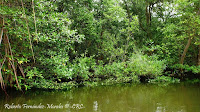














































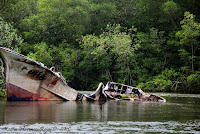



























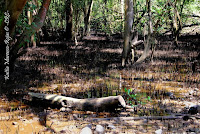








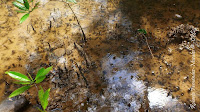













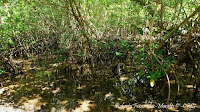









































































































3 comentarios:
Una vez mas puedo decir que este blog es una belleza. Increible fotografias del manglar..una belleza, la espatula rosada.....sin palabras. Muy importante lo que mencionas respecto a la conciencia que debemos tomar para la conservacion de nuestro bello pais, lo que la fotografia del pelicano herido toca las fibras...Excelente trabajo, los felicito. Un gran beso!
Querida Libia:
Gracias por el comentario. Definitivamente debemos hacer grandes esfuerzos por conservar nuestros recursos naturales y es increíble que un lugar tan bello, que se encuentra tan cerca de nosotros, no es visitado por una mayor cantidad de personas. Debemos hacer más turismo a lo interno y realmente apreciar lo que tenemos.
Un beso.
Yo nací en Puntarenas,vivía cerca del manglar,ahora vivo en Guanacaste,ahora por la pandemia no puedo visitar a mis abuelos,pero cuándo iba,veía el Manglar,deberían limpiarlo,cuidarlo,y declararlo sitio Ramsar,hay una flora y fauna increibles👍
Publicar un comentario